|
An Amazonian Traditional for accelerated
healing of wounds and cuts

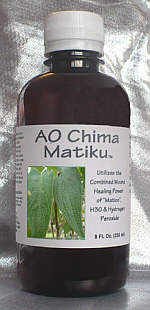
Summarized Description:
Chima Matiku (its Quechuan name, also commonly known
as simply "Matico") is a wound-healing plant found only in Ecuador.
The term "matico," however, has become, in South America, a term which
relates more to function than to exact plant species. The two
plants used in this formula, by way of example, don't even belong
to the same taxonomical family. The information available on
Piper aduncum L. (Piperaceae), which is prolific and
grows in far more diverse environs, is -- as one would expect --
much more abundant.
Taylor [ 1 ] tells of the South
American legend of a wounded Spanish soldier named Matico, who
"probably learned from the Indians that applying the leaves to his
wounds stopped them from bleeding, hence the name 'matico' or 'soldier's
herb or tree.' I cannot verify this legend from independent sources,
but I have spoken extensively with friends, veteran Ecuadorean army soldiers of the
Orienté, many of them veterans of the
Alto Cenepa War,
and an inordinate number claim to have carried "matico" leaves when they
were in battle. So important was it to be able to heal wounds quickly --
particularly when fighting in the jungle.
 Duke also mentions a source relating how
"matico" was introduced in the U.S. and Europe as a styptic and astringent for wounds
by a Liverpool physician in 1839. [ 2 ] Regardless,
I know from my own indigenous sources that the use of "matico" for accelerating
the healing of cuts and wounds goes far back into antiquity.
 Because H3O
is, itself, a wound accelerant and was used for this purpose by physicians
prior to the FDA destruction
of our U.S. lab in 2003, we wanted to know if there was a synergistic
effect from using Matico with H3O -- and although results were preliminary,
we could clearly see that it did.
 Out of this effort comes our
Chima Matiko.
 aticos (both
varieties) are widely used traditionals found
primarily throughout the lower level Andes mountains. The leaves and
stems are the primary medicant used. It has many medicinal uses,
but the focus of our formulation is as a wound
healer. Although Aristeguietia glutinosa L. is making
a comeback in Loja province, where we obtain our leaves -- and we
even have friends who are cultivating it -- it
is still listed as an "endangered species"
due to past deforestation in
the Andean highlands. And so, if nothing more than out of respect,
we formulated this product together with its namesake from Peru, whose
leaves have the same wound-healing property. aticos (both
varieties) are widely used traditionals found
primarily throughout the lower level Andes mountains. The leaves and
stems are the primary medicant used. It has many medicinal uses,
but the focus of our formulation is as a wound
healer. Although Aristeguietia glutinosa L. is making
a comeback in Loja province, where we obtain our leaves -- and we
even have friends who are cultivating it -- it
is still listed as an "endangered species"
due to past deforestation in
the Andean highlands. And so, if nothing more than out of respect,
we formulated this product together with its namesake from Peru, whose
leaves have the same wound-healing property.
 This formula is designed for external use only. This formula is designed for external use only.
Uses & Protocols
 Our Chima Matiko is anti-microbial across
all classes of pathogenic organisms. It is an astringent; accelerates blood clotting;
and initiated a series of actions that speeds up the healing process. Our Chima Matiko is anti-microbial across
all classes of pathogenic organisms. It is an astringent; accelerates blood clotting;
and initiated a series of actions that speeds up the healing process.
 It can be poured liberally over
a cut or wound, or, if the wound not severe, dabbed with cotton gauze,
pad, or a Q-tip®. It can be poured liberally over
a cut or wound, or, if the wound not severe, dabbed with cotton gauze,
pad, or a Q-tip®.
Ingredients
 Extract of Peruvian matico (Piper aduncum L.),
Chima Matiku (Aristeguietia glutinosa L.),,
H3O solution, hydrogen peroxide. Extract of Peruvian matico (Piper aduncum L.),
Chima Matiku (Aristeguietia glutinosa L.),,
H3O solution, hydrogen peroxide.
Shelf-Life
 This product has a shelf-life
of not less than five years from the date of purchase. This product has a shelf-life
of not less than five years from the date of purchase.
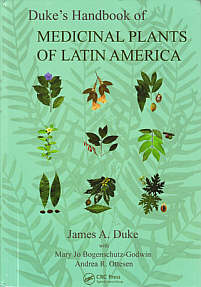
Medicinal Activities
 Further information for practitioners:
World-famous botanist Dr. James Duke attributes the following activities
to "matico" (Piper aduncum L. -- Piperaceae family),
(p. 548-552; see hardcopy cover at right),
drawn from the extant literature. (See his "level of efficacy" classification
on our amazon traditionals page;
followed by Duke's bibliographic abbreviations (in capital letters),
which we identify
on a separate page.) Further information for practitioners:
World-famous botanist Dr. James Duke attributes the following activities
to "matico" (Piper aduncum L. -- Piperaceae family),
(p. 548-552; see hardcopy cover at right),
drawn from the extant literature. (See his "level of efficacy" classification
on our amazon traditionals page;
followed by Duke's bibliographic abbreviations (in capital letters),
which we identify
on a separate page.)
- Antigonorrheal (1; X8583798);
- Antihemorrhagic (f: RA2);
- Antiinflammatory (f; RA2);
- Anti-leishmanic (1; RA2; X10223942; X10390243);
- Antinauseant (f; RA2);
- Antiseptic (f1; DAV; MD2; RA2);
- Antispasmodic (f; RA2);
- Antiviral (1; RA2);
- Antiyeast (1; RA2);
- Aphrodisiac (f; HHB);
- Astringent (f1: MAD; MD1, RA2);
- Bactericide (1; RA2; X15894143; X8158163);
- Candidicide (1; RA2, X17234373);
- Carminative (f; RA2);
- Cholagogue (f: MPB; RA2);
- Cicatrizant (f; DLZ; RA2);
- Cytotoxic (1; RA2; X8158163);
- Decongestant (f; RA2);
- Depurative (f: RA2);
- Digestive (f; RA2);
- Diuretic (f; HHB; JFM; RA2);
- Expectorant (f; RA2);
- Fungicide (1; RA2);
- Gram(+)icide (1; RA2; X15894143);
- Gram(-)icide (1; RA2; X15894143);
- Homostat (f1; MAD, MD2, PH2, RA2);
- Insecticide (f1; JFM; RA);
- Laxative (f; JFM);
- Moluscacide (1; RA2; X8302955);
- Mucolytic (f; RA2);
- Nervine (f: RA2);
- PAF-Inhibitor (1; X15693713);
- Panacea (f; RA2);
- Pectoral (f; DLZ);
- Purgative (f; RA2);
- Resolvent (f; RA2);
- Sedative (f; JFM);
- Stimulant (f; JFM; MAD; RA2);
- Stomachic (f; RA2);
- Styptic (f; RA2);
- Tonic (f; MAD, RA2);
- Uterotonic (f; RA2);
- Vulnerary (f; MAD; RA2).
Indications
 Further information for practitioners:
Duke provides the following indications for this plant: Further information for practitioners:
Duke provides the following indications for this plant:
- Bacteria (f1; HHB; PH2; RA2; X15894143; X8158163; X8302955).
- Bites (f; PH2);
- Bleeding (f1; HHB; MAD; MD2; PH2; RA2);
- Bronchosis (f; DAV; RA2);
- Cancer, stomach (f; RA2);
- Candida (1; RA2; X17234373);
- Catarrh (f; MAD; RA2);
- Cholera (f; MPB);
- Colds (f; RA2);
- Congestion (f; RA2);
- Constipation (f; JFM);
- Coughs (f; RA2);
- Cystitosis (f; JFM; MAD; RA2);
- Diarrhea (f; JFM; PH2; RA2);
- Digestion (f; RA2);
- Dysentery (f; JFM; PH2; RA2);
- Dysmenorrhea (f; DAV; DLZ);
- Dyspepsia (f; DAV; RA2);
- Dysuria (f; MAD);
- Enterosis (f; DAV; RA2);
- Epistaxis (f; MAD);
- Fever (f; RA2);
- Fungus (f; RA2);
- Hematuria (f; DLZ; MAD);
- Hemoptysis (f; JFM; HHB);
- Hemorrhage (f; RA2);
- Hemorrhoids (f; JFM; MAD);
- Impotence (f; HHB);
- Infection (f1; DAV; HHB; JFM; MD2; PH2, RA2; X158947143; X8158163; X8302955);
- Inflammation (f; DAV; JFM; RA2);
- Insomnia (f; JFM);
- Kidney Stones (f; RA2);
- Leishmania (f1; MD2; RA2; X10223942; X10390243);
- Leucorrhea (f; JFM; MAD; MPB; RA2);
- Malaria (f; DAV);
- Menorrhagia (f; JFM; MAD; MD2);
- Menstrual Colic (f; RA2);
- Nausea (f; RA2);
- Odontosis (f; PH2);
- Pain (f; MD2);
- Parasites (f; DLZ);
- Pleurisy (f; RA2);
- Pneumonia (f; RA2);
- Polio (1; RA2; X12165336);
- Prolapse (f; JFM; MPB; RA2);
- Pulmonosis (f; MAD);
- Rheumatism (f; DAV; RA2);
- Sores (f; PH2; RA2);
- Sore Throat (f; MD2; RA2);
- Spasms (f; RA2);
- Stomachache (f; RA2);
- Tonsilitis (f; RA2);
- Trichomonas (f; RA2);
- Ulcers (f; RA2);
- Urethritis (f; RA2);
- Urogenitosis (f; PH2; RA2);
- Uterosis (f; JFM; MAD; MPB; RA2);
- Vaginosis (f; DAV; RA2);
- VD (f1; JFM; MAD; RA2; X8583798);
- Vomiting (f; RA2);
- Wounds (f1; DLZ, HHB; MAD; PH2; RA2);
- Yeast (1; RA2; X17234373).

Greg Caton --- Founder
Alpha Omega Labs
Guayaquil, Ecuador
|
 To U.S. Users: To U.S. Users: This product
have not been evaluated by the U.S. Food & Drug Administration.
It is not intended to diagnose, treat, cure, or prevent any disease.
|
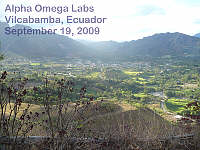 Sourcing From
Sourcing From
The Andes
 Our Chima Matiku is sourced
from the Andes mountains. ( Piper aduncum L. is sourced
from Northern Peru).
Click photo to enlarge.
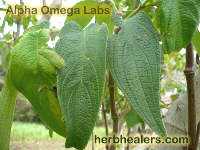
 The leaves are the most
commonly used part of the Matiku tree. In addition to its
wound-healing properties, both species of "matico" in this
formula are aromatic.
Click to enlarge.
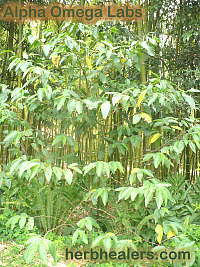
 Ecuadorean Matiku trees thrive
in the Andes mountains of Southern Ecuador.
This picture was taken on the Vilcabamba hacienda of Mike Adams,
"Health Ranger" and publisher of NaturalNews.com.
Click to enlarge.
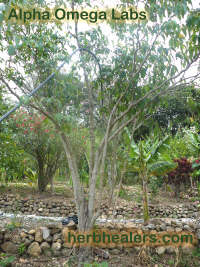
 Matikus are often
used as ornamentals -- as seen in this photo, also taken
in Vilcabamba, Ecuador.
Click to enlarge.
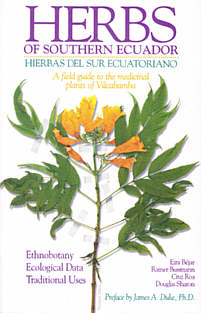
 My first exposure to
Matiku was in the excellent, bilingual field guide,
"Herbs of Southern Ecuador: A Field Guide to the Medicinal
Plants of Vilcabamba" -- based largely on the life long
work of herbalist and curendero, Don Cruz Roa, who lives
just north of the town itself. [Therein, the plant is
referred to as Matico (Piper augustifolium L.;
which we believe to have been a small taxonomical error). ]
Click to enlarge.
Ethnobotanical
Usage
 Duke provides a wide variety of ethnobotanical
usage and dosage examples. Below, we include just a sampling of the historic
use of this plant as it relates to wound healing:
- Amazon Indians sprinkle crushed or powdered leaves onto cuts, ulcers, and wounds,
or use the leaf tea infusion as a wash, or heated and pounded leaves as a
poultice (RA2)
- Amazon Indians use the leaves as antiseptic, for bleeding, infection, and
wounds (RA2).
- Americans (native) consider (the plant) astringent, diffusive, hemostat, soothing,
urinary tonic, and vulnerary, taking leaf infusion for blennorrhagia, cholera,
diarrhea, dysentery, dyspepsia, gonorrhea, hemorrhoids, leucorrhea, pulmonary
or postpartum hemorrhages, and as a birthing aid, using topically as an astringent
and styptic on ulcers, wounds, and top stop bleeding. (RA2).
- Brazilians take leaf infusion as antiinflammatory, antispasmodic, carminative,
diuretic, stomachic, tonic, and vulnerary, for blennorrhagia, cholera, cystitis, diarrhea,
digestive disorders, dysentery, liver problems, pyelitis, wounds, and as uterine tonic
to prevent prolapse (MPB; RA2).
- Colombians use for pulmonary hemorrhages (RA2) . . . constipation, leucorrhea, kidney
stones, pneumonnia, and stomachaches, inhaling powdered leaf for nose bleeds.
- Guyanans paste macerated leaves and stems onto sores and wounds as vulnerary (RA2).
- Haitians use the plant as aphrodisiac and hemostat, for blennorrhagia, dropsy,
hepatoses, leucorrhea, rheumatism, skin problems and sores. (RA2)
- Hondurans take leaf decoction for aches, pains, and as a digestive aid,
applying topically as a skin cleaner (RA2).
- Karijona Indians use as styptic and vulnerary, sprinkling dried leaf onto
wounds (DAV; RA2; SAR).
- Madre de Dios Peruvians use leaves as antiseptic and hemostat, the decoction for colds,
conjunctivitis, and sore throats, and leaf tea for bleeding following childbirth and kidney
pains, and apply leaves in honey to leishmanial sores (MD2).
- New Guineans take leaf infusion for colds and diarrhea, using topically as antiseptic
and to heal wounds (RA2).
- Panamanians use the plant for bronchitis, cancer, decubitus ulcers, pleurisy,
pneumonia, respiratory problems, stomach problems, trichomoniasis, ulcers, uterine disorders,
vaginitis, and wounds. (RA2)
- Puruvians eat the leaves as a "cure-all" (RA2)
|








